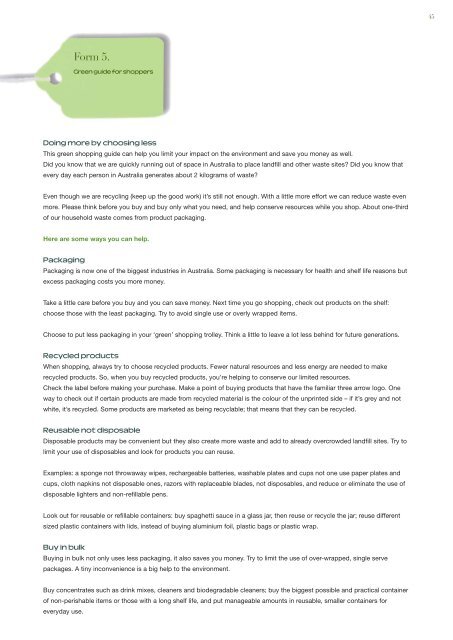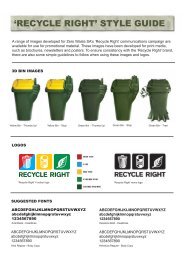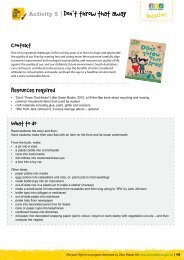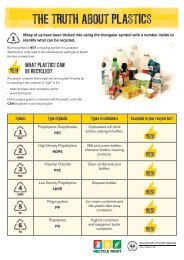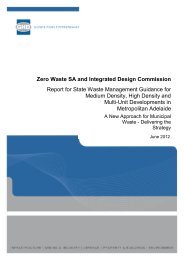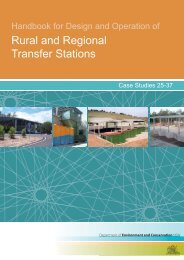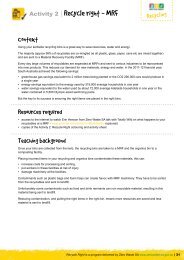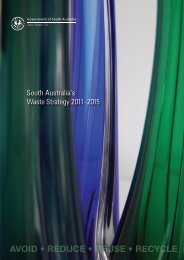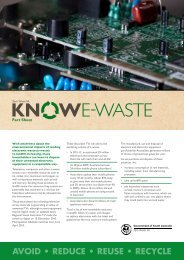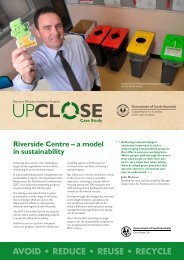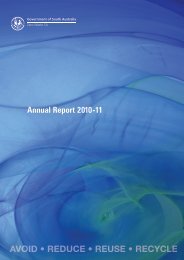Waste management and reduction guide for retail industry
Waste management and reduction guide for retail industry
Waste management and reduction guide for retail industry
- No tags were found...
You also want an ePaper? Increase the reach of your titles
YUMPU automatically turns print PDFs into web optimized ePapers that Google loves.
45Form 5.Green <strong>guide</strong> <strong>for</strong> shoppersDoing more by choosing lessThis green shopping <strong>guide</strong> can help you limit your impact on the environment <strong>and</strong> save you money as well.Did you know that we are quickly running out of space in Australia to place l<strong>and</strong>fill <strong>and</strong> other waste sites? Did you know thatevery day each person in Australia generates about 2 kilograms of waste?Even though we are recycling (keep up the good work) it’s still not enough. With a little more ef<strong>for</strong>t we can reduce waste evenmore. Please think be<strong>for</strong>e you buy <strong>and</strong> buy only what you need, <strong>and</strong> help conserve resources while you shop. About one-thirdof our household waste comes from product packaging.Here are some ways you can help.PackagingPackaging is now one of the biggest industries in Australia. Some packaging is necessary <strong>for</strong> health <strong>and</strong> shelf life reasons butexcess packaging costs you more money.Take a little care be<strong>for</strong>e you buy <strong>and</strong> you can save money. Next time you go shopping, check out products on the shelf:choose those with the least packaging. Try to avoid single use or overly wrapped items.Choose to put less packaging in your ‘green’ shopping trolley. Think a little to leave a lot less behind <strong>for</strong> future generations.Recycled productsWhen shopping, always try to choose recycled products. Fewer natural resources <strong>and</strong> less energy are needed to makerecycled products. So, when you buy recycled products, you’re helping to conserve our limited resources.Check the label be<strong>for</strong>e making your purchase. Make a point of buying products that have the familiar three arrow logo. Oneway to check out if certain products are made from recycled material is the colour of the unprinted side – if it’s grey <strong>and</strong> notwhite, it’s recycled. Some products are marketed as being recyclable; that means that they can be recycled.Reusable not disposableDisposable products may be convenient but they also create more waste <strong>and</strong> add to already overcrowded l<strong>and</strong>fill sites. Try tolimit your use of disposables <strong>and</strong> look <strong>for</strong> products you can reuse.Examples: a sponge not throwaway wipes, rechargeable batteries, washable plates <strong>and</strong> cups not one use paper plates <strong>and</strong>cups, cloth napkins not disposable ones, razors with replaceable blades, not disposables, <strong>and</strong> reduce or eliminate the use ofdisposable lighters <strong>and</strong> non-refillable pens.Look out <strong>for</strong> reusable or refillable containers: buy spaghetti sauce in a glass jar, then reuse or recycle the jar; reuse differentsized plastic containers with lids, instead of buying aluminium foil, plastic bags or plastic wrap.Buy in bulkBuying in bulk not only uses less packaging, it also saves you money. Try to limit the use of over-wrapped, single servepackages. A tiny inconvenience is a big help to the environment.Buy concentrates such as drink mixes, cleaners <strong>and</strong> biodegradable cleaners; buy the biggest possible <strong>and</strong> practical containerof non-perishable items or those with a long shelf life, <strong>and</strong> put manageable amounts in reusable, smaller containers <strong>for</strong>everyday use.


